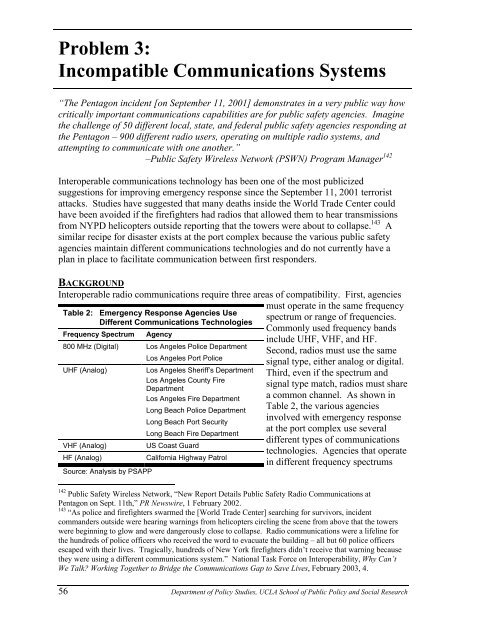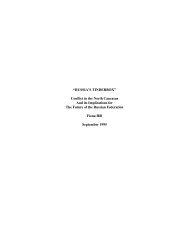Port Security Applied Policy Project - Belfer Center for Science and ...
Port Security Applied Policy Project - Belfer Center for Science and ...
Port Security Applied Policy Project - Belfer Center for Science and ...
You also want an ePaper? Increase the reach of your titles
YUMPU automatically turns print PDFs into web optimized ePapers that Google loves.
Problem 3:<br />
Incompatible Communications Systems<br />
“The Pentagon incident [on September 11, 2001] demonstrates in a very public way how<br />
critically important communications capabilities are <strong>for</strong> public safety agencies. Imagine<br />
the challenge of 50 different local, state, <strong>and</strong> federal public safety agencies responding at<br />
the Pentagon – 900 different radio users, operating on multiple radio systems, <strong>and</strong><br />
attempting to communicate with one another.”<br />
–Public Safety Wireless Network (PSWN) Program Manager 142<br />
Interoperable communications technology has been one of the most publicized<br />
suggestions <strong>for</strong> improving emergency response since the September 11, 2001 terrorist<br />
attacks. Studies have suggested that many deaths inside the World Trade <strong>Center</strong> could<br />
have been avoided if the firefighters had radios that allowed them to hear transmissions<br />
from NYPD helicopters outside reporting that the towers were about to collapse. 143 A<br />
similar recipe <strong>for</strong> disaster exists at the port complex because the various public safety<br />
agencies maintain different communications technologies <strong>and</strong> do not currently have a<br />
plan in place to facilitate communication between first responders.<br />
BACKGROUND<br />
Interoperable radio communications require three areas of compatibility. First, agencies<br />
Table 2: Emergency Response Agencies Use<br />
Different Communications Technologies<br />
Frequency Spectrum Agency<br />
800 MHz (Digital) Los Angeles Police Department<br />
Los Angeles <strong>Port</strong> Police<br />
UHF (Analog) Los Angeles Sheriff’s Department<br />
Los Angeles County Fire<br />
Department<br />
Los Angeles Fire Department<br />
Long Beach Police Department<br />
Long Beach <strong>Port</strong> <strong>Security</strong><br />
Long Beach Fire Department<br />
VHF (Analog) US Coast Guard<br />
HF (Analog) Cali<strong>for</strong>nia Highway Patrol<br />
Source: Analysis by PSAPP<br />
must operate in the same frequency<br />
spectrum or range of frequencies.<br />
Commonly used frequency b<strong>and</strong>s<br />
include UHF, VHF, <strong>and</strong> HF.<br />
Second, radios must use the same<br />
signal type, either analog or digital.<br />
Third, even if the spectrum <strong>and</strong><br />
signal type match, radios must share<br />
a common channel. As shown in<br />
Table 2, the various agencies<br />
involved with emergency response<br />
at the port complex use several<br />
different types of communications<br />
technologies. Agencies that operate<br />
in different frequency spectrums<br />
142 Public Safety Wireless Network, “New Report Details Public Safety Radio Communications at<br />
Pentagon on Sept. 11th,” PR Newswire, 1 February 2002.<br />
143 “As police <strong>and</strong> firefighters swarmed the [World Trade <strong>Center</strong>] searching <strong>for</strong> survivors, incident<br />
comm<strong>and</strong>ers outside were hearing warnings from helicopters circling the scene from above that the towers<br />
were beginning to glow <strong>and</strong> were dangerously close to collapse. Radio communications were a lifeline <strong>for</strong><br />
the hundreds of police officers who received the word to evacuate the building – all but 60 police officers<br />
escaped with their lives. Tragically, hundreds of New York firefighters didn’t receive that warning because<br />
they were using a different communications system.” National Task Force on Interoperability, Why Can’t<br />
We Talk? Working Together to Bridge the Communications Gap to Save Lives, February 2003, 4.<br />
56 Department of <strong>Policy</strong> Studies, UCLA School of Public <strong>Policy</strong> <strong>and</strong> Social Research
















